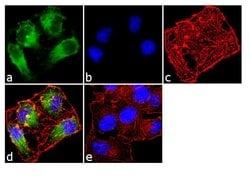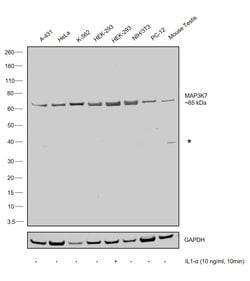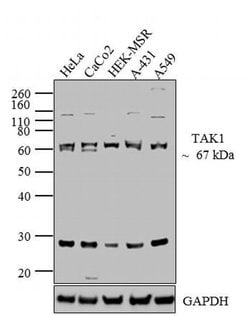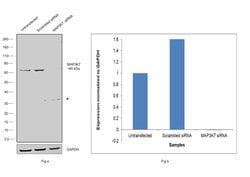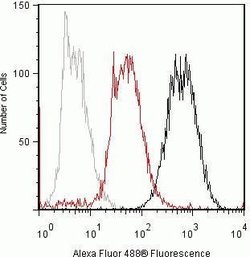Learn More
Invitrogen™ TAK1 Recombinant Rabbit Monoclonal Antibody (28H25L68)
Rabbit Recombinant Monoclonal Antibody
Supplier: Invitrogen™ 700113
Description
This antibody is predicted to react with Rhesus monkey, orangutan, chimpanzee, mouse, rat, equine, porcine, bovine, chicken, Xenopus and zebrafish based on sequence homology. Intact IgG appears on a non-reducing gel as ~150 kDa band and upon reduction generating a ~25 kDa light chain band and a ~50 kDa heavy chain. Recombinant rabbit monoclonal antibodies are produced using in vitro expression systems. The expression systems are developed by cloning in the specific antibody DNA sequences from immunoreactive rabbits. Then, individual clones are screened to select the best candidates for production. The advantages of using recombinant rabbit monoclonal antibodies include: better specificity and sensitivity, lot-to-lot consistency, animal origin-free formulations, and broader immunoreactivity to diverse targets due to larger rabbit immune repertoire.
TAK1 (also known as MAP3K7), a part of the serine/threonine kinase family, is a versatile protein with many signaling functions. Originally identified as a TGF- beta-activated kinase, TAK1 interacts with TGF- beta-receptor and TRAF6 to modulate TGF- beta activation of JNK and p38. It has additional roles in activation of p38 and JNK through Wnt, BMP, and activin signaling pathways as well in response to thyroid hormone, osmotic stress, endothelin, and ephrine. Through activation of von Hippel-Lindau tumor suppressor expression, TAK1 represses PDGF-B, integrin beta1 and integrin beta5, promoting proper wound healing. TAK1 also plays an essential role in IKK activation in numerous signaling pathways including IL-1, IL-6, IL-18, TNF, CD40, TLR, and RIG-I. Activation of the TAK1-IKK pathway requires TAB2/3 and ubiquitination. In this process, TAB2/3 binds to the C-terminal region of TAK1 and becomes polyubiquitinated, TAK1 is autophosphorylated at Thr178, Thr184, Thr187 and Ser192, and finally TAK1 phosphorylates IKK- beta. Additionally, TAK1 represses human telomerase reverse transcriptase suggesting a role in regulation of cell lifespan.
Specifications
| TAK1 | |
| Recombinant Monoclonal | |
| 0.5 mg/mL | |
| PBS with 0.09% sodium azide | |
| O43318, P0C8E4, Q62073 | |
| MAP3K7 | |
| A recombinant protein corresponding to amino acids 476-606 of O43318. | |
| 100 μg | |
| Primary | |
| Human, Mouse, Rat | |
| Antibody | |
| IgG |
| Flow Cytometry, Western Blot, Immunocytochemistry | |
| 28H25L68 | |
| Unconjugated | |
| MAP3K7 | |
| B430101B05; C87327; hypothetical protein LOC553788; I79_000697; M3K7; map3k7; map3k7.L; MAPKKK; MEKK7; mitogen activated protein kinase kinase kinase 7; mitogen-activated protein kinase kinase kinase 7; mitogen-activated protein kinase kinase kinase 7 L homeolog; RP1-154G14.1; si:ch211-225h9.1; Tak1; TAK1z; TGF1a; TGF-beta activated kinase 1; TGF-beta-activated kinase 1; TGF-beta-activated kinase TAK1; transforming growth factor beta-activated kinase 1; transforming growth factor-beta-activated kinase 1; XELAEV_18027270mg; xTAK1; zgc:110612 | |
| Rabbit | |
| Protein A | |
| RUO | |
| 26409, 313121, 6885 | |
| Store at 4°C short term. For long term storage, store at -20°C, avoiding freeze/thaw cycles. | |
| Liquid |
Safety and Handling
Your input is important to us. Please complete this form to provide feedback related to the content on this product.
